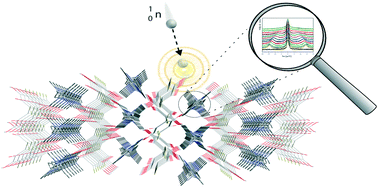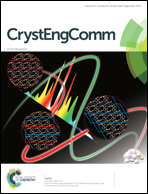Crystal structural analysis of methyl-substituted pyrazines with anilic acids: a combined diffraction, inelastic neutron scattering, 1H-NMR study and theoretical approach†
Abstract
The crystal and molecular structures of (1) 2-methylpyrazine (2MP) with 2,5-dichloro-3,6-dihydroxy-p-quinone (chloranilic acid, CLA), (2) 2-methylpyrazine (2MP) with 2,5-dibromo-3,6-dihydroxy-p-quinone (bromanilic acid, BRA), (3) 2,3,5-trimethylpyrazine (TrMP) with 2,5-dichloro-3,6-dihydroxy-p-quinone (chloranilic acid, CLA), and (4) 2,3,5-trimethylpyrazine (TrMP) with 2,5-dibromo-3,6-dihydroxy-p-quinone (bromanilic acid, BRA) were analyzed in terms of the number of independent methyl groups in their crystal structure. The inelastic neutron back-scattering spectra at low temperature (4–40 K) were discussed in terms of methyl group tunnelling. The INS spectra were compared with the temperature dependence of the 1H-NMR spin–lattice relaxation time, particularly at low temperatures, where CH3 tunnelling is postulated. The infrared and Raman spectra at room temperature were recorded for all complexes under investigation. Furthermore, the vibrational spectra were discussed in terms of the structure of molecules and their interactions. The structural phase transition of the TrMP·CLA complex at 171/175 K (cooling/heating) was characterized by DSC and single-crystal X-ray diffraction. Full-geometry optimization was carried out in the solid state in order to obtain the minimum structures and bonding properties. The results are in very good agreement with the experimental data. The infrared spectrum in the harmonic approximation was calculated and a comparative vibrational analysis was performed. CRYSTAL09 vibrational results appear to be in good agreement with the experimental results.



 Please wait while we load your content...
Please wait while we load your content...